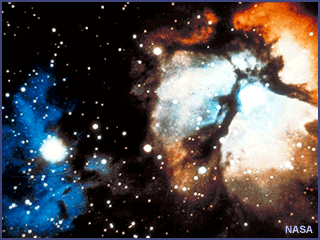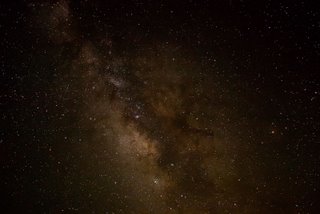Crazy Thing
Thursday, July 27, 2006
Milky Way
This is some information i found on Wikipedia about Milky Way, our homeland.
"The Milky Way (a translation of the Latin Via Lactea, in turn derived from the Greek Γαλαξίας (Galaxias), sometimes referred to simply as "the Galaxy"), is a barred spiral galaxy which forms part of the Local Group. Although the Milky Way is but one of billions of galaxies in the universe, the Galaxy has special significance to humanity as it is the home of the solar system. Democritus (450 BC - 370 BC) was the first known person to claim that the Milky Way consists of distant stars.
View from Earth of a portion of the Milky Way near Sagittarius.
The term "milky" originates from the hazy band of white light appearing across the celestial sphere visible from Earth, which comprises stars and other material lying within the galactic plane. The galaxy appears brightest in the direction of Sagittarius, towards the galactic center.
Relative to the celestial equator, the Milky Way passes as far north as the constellation of Cassiopeia and as far south as the constellation of Crux, indicating the high inclination of Earth's equatorial plane and the plane of the ecliptic relative to the galactic plane. The fact that the Milky Way divides the night sky into two roughly equal hemispheres indicates that the solar system lies close to the galactic plane.
The main disk of the Milky Way Galaxy is about 80,000 to 100,000 light years in diameter, about 250-300 thousand light years in circumference, and outside the Galactic core, about 1,000 light years in thickness. It is composed of 200 to 400 billion stars . As a guide to the relative physical scale of the Milky Way, if the galaxy were reduced to 130 km (80 mi) in diameter, the solar system would be a mere 2 mm (0.08 in) in width. The Galactic Halo extends out to 250,000 to 400,000 light years in diameter. As detailed in the Structure section below, new discoveries indicate that the disk extends much farther than previously thought.
NASA artist's conception of the Milky Way Galaxy, viewed along its axis.
The Milky Way's absolute magnitude, which cannot be measured directly, is assumed by astronomical convention to be −20.5."
Tuesday, July 18, 2006
Beside us
How might we detect such distant life? Not likely with fleets of starships. The energies required for star travel (barring a science-fiction style warp drive) are simply too great and travel times too long. Instead, sophisticated ground and space-based telescopes are being used to detect planets of nearby star systems. How planets block the light of their star as detected from Earth can reveal the chemical composition of the planet's atmosphere. Some scientists believe that the chemical composition of the planet's atmosphere will provide evidence of the presence of life. How is this possible? How can simple gases tell us about the presence or absence of life as we know it? To answer that, we must look at our own planet.
Earth has a radius of some 6400 km. Ninety-nine percent of the earth's atmosphere is contained within a layer approximately 50 km thick. Life on earth inhabits a layer no more than 9 km thick, extending from a bare few kilometers above sea level (airborne organisms and life on mountains) to a few kilometers below (deep ocean basin creatures and subterranean microbial communities).
One night space

What a beautiful scene.Thanks to God
It would be among the most profound discoveries in the history of our species if we could detect life on other planets circling other stars in the galaxy. Whether the life turns out to be intelligent, technological, or simply microbial, such a discovery would provide evidence that we are not alone, that life (in one form or another) is widespread in a universe that suddenly seems less stark and empty


